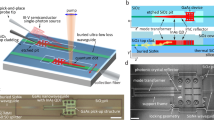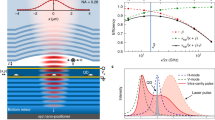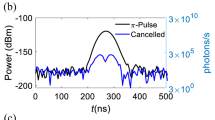Abstract
Microwaves have widespread use in classical communication technologies, from long-distance broadcasts to short-distance signals within a computer chip. Like all forms of light, microwaves, even those guided by the wires of an integrated circuit, consist of discrete photons1. To enable quantum communication between distant parts of a quantum computer, the signals must also be quantum, consisting of single photons, for example. However, conventional sources can generate only classical light, not single photons. One way to realize a single-photon source2 is to collect the fluorescence of a single atom. Early experiments measured the quantum nature of continuous radiation3,4, and further advances allowed triggered sources of photons on demand5,6,7,8,9,10,11. To allow efficient photon collection, emitters are typically placed inside optical or microwave cavities12,13,14,15,16,17,18,19, but these sources are difficult to employ for quantum communication on wires within an integrated circuit. Here we demonstrate an on-chip, on-demand single-photon source, where the microwave photons are injected into a wire with high efficiency and spectral purity. This is accomplished in a circuit quantum electrodynamics architecture20, with a microwave transmission line cavity that enhances the spontaneous emission of a single superconducting qubit. When the qubit spontaneously emits, the generated photon acts as a flying qubit, transmitting the quantum information across a chip. We perform tomography of both the qubit and the emitted photons, clearly showing that both the quantum phase and amplitude are transferred during the emission. Both the average power and voltage of the photon source are characterized to verify performance of the system. This single-photon source is an important addition to a rapidly growing toolbox for quantum optics on a chip.
This is a preview of subscription content, access via your institution
Access options
Subscribe to this journal
Receive 51 print issues and online access
$199.00 per year
only $3.90 per issue
Buy this article
- Purchase on Springer Link
- Instant access to full article PDF
Prices may be subject to local taxes which are calculated during checkout





Similar content being viewed by others
References
Schuster, D. I. et al. Resolving photon number states in a superconducting circuit. Nature 445, 515–518 (2007)
Oxborrow, M. & Sinclair, A. Single-photon sources. Contemp. Phys. 46, 173–206 (2005)
Clauser, J. F. Experimental distinction between the quantum and classical field-theoretic predictions for the photoelectric effect. Phys. Rev. D 9, 853–860 (1974)
Kimble, H. J., Dagenais, M. & Mandel, L. Photon antibunching in resonance fluorescence. Phys. Rev. Lett. 39, 691–695 (1977)
Diedrich, F. & Walther, H. Nonclassical radiation of a single stored ion. Phys. Rev. Lett. 58, 203–206 (1987)
Basche, T., Moerner, W. E., Orrit, M. & Talon, H. Photon antibunching in the fluorescence of a single dye molecule trapped in a solid. Phys. Rev. Lett. 69, 1516–1519 (1992)
Brunel, C., Lounis, B., Tamarat, P. & Orrit, M. Triggered source of single photons based on controlled single molecule fluorescence. Phys. Rev. Lett. 83, 2722–2725 (1999)
Lounis, B. & Moerner, W. E. Single photons on demand from a single molecule at room temperature. Nature 407, 491–493 (2000)
Kurtsiefer, C., Mayer, S., Zarda, P. & Weinfurter, H. Stable solid-state source of single photons. Phys. Rev. Lett. 85, 290–293 (2000)
Michler, P. et al. Quantum correlation among photons from a single quantum dot at room temperature. Nature 406, 968–970 (2000)
Darquie, B. et al. Controlled single-photon emission from a single trapped two-level atom. Science 309, 454–456 (2005)
Maitre, X. et al. Quantum memory with a single photon in a cavity. Phys. Rev. Lett. 79, 769–772 (1997)
Brattke, S., Varcoe, B. T. H. & Walther, H. Generation of photon number states on demand via cavity quantum electrodynamics. Phys. Rev. Lett. 86, 3534–3537 (2001)
Moreau, E. et al. Single-mode solid-state single photon source based on isolated quantum dots in pillar microcavities. Appl. Phys. Lett. 79, 2865–2867 (2001)
Santori, C., Fattal, D., Vuckovic, J., Solomon, G. S. & Yamamoto, Y. Indistinguishable photons from a single-photon device. Nature 419, 594–597 (2002)
Pelton, M. et al. Efficient source of single photons: A single quantum dot in a micropost microcavity. Phys. Rev. Lett. 89, 233602 (2002)
Kuhn, A., Hennrich, M. & Rempe, G. Deterministic single-photon source for distributed quantum networking. Phys. Rev. Lett. 89, 067901 (2002)
McKeever, J. et al. Deterministic generation of single photons from one atom trapped in a cavity. Science 303, 1992–1994 (2004)
Keller, M., Lange, B., Hayasaka, K., Lange, W. & Walther, H. Continuous generation of single photons with controlled waveform in an ion-trap cavity system. Nature 431, 1075–1078 (2004)
Blais, A., Huang, R.-S., Wallraff, A., Girvin, S. M. & Schoelkopf, R. J. Cavity quantum electrodynamics for superconducting electrical circuits: An architecture for quantum computation. Phys. Rev. A. 69, 062320 (2004)
Purcell, E. M. Spontaneous emission probabilities at radio frequencies. Phys. Rev. 69, 681 (1946)
Koch, J. et al. Charge insensitive qubit design derived from the Cooper pair box. Phys. Rev. A (in the press); preprint at 〈http://arxiv.org/cond-mat/0703002〉 (2007)
Bouchiat, V., Vion, D., Joyez, P., Esteve, D. & Devoret, M. H. Quantum coherence with a single cooper pair. Phys. Scr. T76, 165–170 (1998)
Wallraff, A. et al. Strong coupling of a single photon to a superconducting qubit using circuit quantum electrodynamics. Nature 431, 162–167 (2004)
Wallraff, A. et al. Approaching unit visibility for control of a superconducting qubit with dispersive readout. Phys. Rev. Lett. 95, 060501–060504 (2005)
Steffen, M. et al. State tomography of capacitively shunted phase qubits with high fidelity. Phys. Rev. Lett. 97, 050502 (2006)
Smithey, D. T., Beck, M., Raymer, M. G. & Faridani, A. Measurement of the Wigner distribution and the density matrix of a light mode using optical homodyne tomography: application to squeezed states and the vacuum. Phys. Rev. Lett. 70, 1244–1247 (1993)
Leonhardt, U. Measuring the Quantum State of Light (Cambridge Univ. Press, 1997)
DiVincenzo, D. P. The physical implementation of quantum computation Fortschr. Phys. 48, 771–783 (2000)
Acknowledgements
This work was supported in part by the National Security Agency under the Army Research Office, the NSF, and Yale University. A.A.H. acknowledges support from Yale University via a Quantum Information and Mesoscopic Physics Fellowship.
Author information
Authors and Affiliations
Corresponding author
Ethics declarations
Competing interests
Reprints and permissions information is available at www.nature.com/reprints. The authors declare no competing financial interests.
Rights and permissions
About this article
Cite this article
Houck, A., Schuster, D., Gambetta, J. et al. Generating single microwave photons in a circuit. Nature 449, 328–331 (2007). https://doi.org/10.1038/nature06126
Received:
Accepted:
Issue Date:
DOI: https://doi.org/10.1038/nature06126
This article is cited by
-
Topological single-photon emission from quantum emitter chains
npj Quantum Information (2024)
-
Orbital angular momentum detection device for vortex microwave photons
Communications Engineering (2023)
-
Single-Photon Source with Emission Direction Controlled by a Qubit State
Journal of Low Temperature Physics (2023)
-
A Review of Developments in Superconducting Quantum Processors
Journal of the Indian Institute of Science (2023)
-
Quantum efficiency, purity and stability of a tunable, narrowband microwave single-photon source
npj Quantum Information (2021)
Comments
By submitting a comment you agree to abide by our Terms and Community Guidelines. If you find something abusive or that does not comply with our terms or guidelines please flag it as inappropriate.



